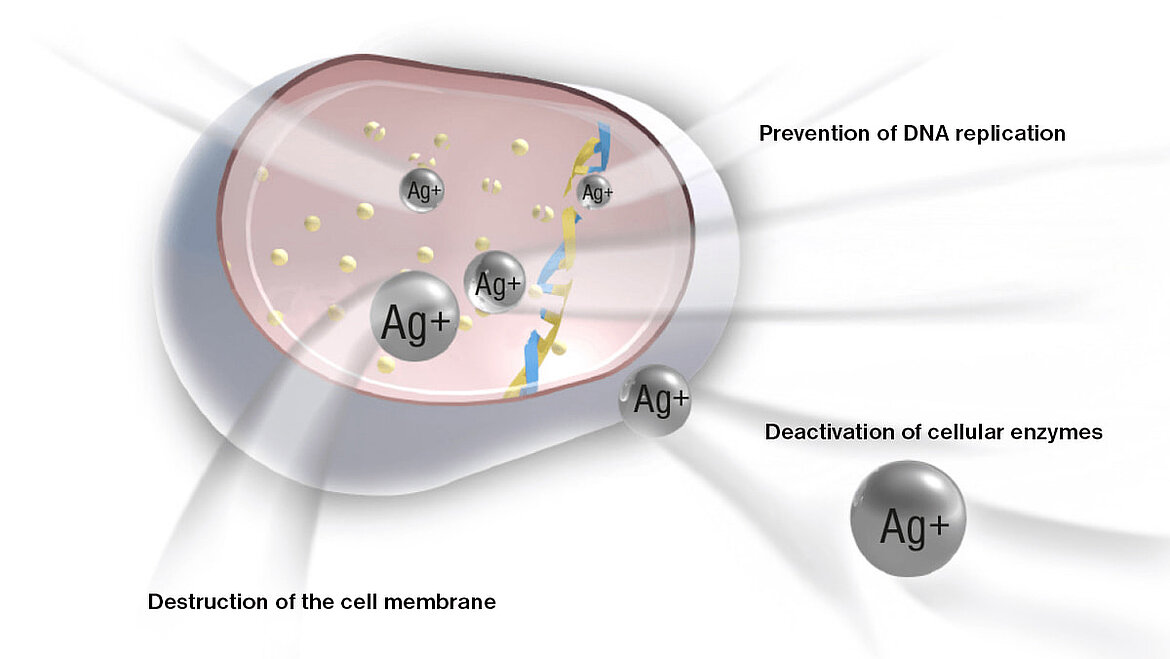Wash your hands properly, sneeze or cough into the crook of your arm: These are behaviours that we teach the youngest ones in our society. In addition to these behaviours, high hygiene standards must be adhered to, especially in hospitals, doctors' practices and care facilities. The antibacterial effect of microsilver can make the crucial difference.

What is microsilver? And how does it work? Silver has an antibacterial, i.e. germ-killing effect. The actual active ingredients here are the silver ions (Ag+), which are released by moisture and migrate to the surface. There, they attack germs in different ways. Basically, these germs are prevented from multiplying in this way.
Germs, bacteria, viruses: What is the difference?
In everyday life, we often speak of germs, but this term is already relatively old. Today, medical professionals talk primarily about pathogens. By this they mean bacteria, yeasts, fungi and viruses. Some of these types of pathogens have their metabolism and can multiply themselves by cell division. Viruses are also classified as pathogens, but they differ from bacteria, yeasts and fungi. Viruses do not have their own metabolism and are therefore always dependent on a host in order to reproduce themselves. Silver has a killing effect on germs. This is why it is advisable to add microsilver to materials in order to take advantage of this effect.
What is the difference between silver and microsilver?
Germs, bacteria, viruses: What is the difference?Biologist Gregor Schneider explains that the difference between microsilver and other silver active ingredients lies in the particle size. The following applies: The smaller a particle is, the more ions are released. This also means that much less raw material is needed to achieve a corresponding effect. Microparticles can thus also be incorporated into very thin fibres, for example microfibre cleaning cloths. In addition, almost all surfaces can be equipped with microsilver.
Effect of microsilver on surfaces
Theoretically, microsilver can be incorporated into powder coatings and lacquers of all kinds: whether water-based, solvent-based or UV-curing. A major advantage: Microparticles cannot be rubbed out of surfaces. So, once they have been incorporated, they last the entire product lifetime. In the case of lacquer, the silver particles can only be effective as long as the lacquer is intact.
And what happens now with germs on a surface that is equipped with microsilver particles? Simply put: The germs are not only prevented from multiplying, but are also killed. Ag+ silver ions have three modes of action:

1. The interaction of silver ions with the cell membrane leads to reduced adhesion of the germs to their substrate, and thus to poor growth conditions.
2. The ions block the cellular enzymes of the germs, thereby interfering with the metabolism and reducing the vitality of the germs.
3. The silver ions cause damage inside the cell due to irreversible interaction with sulphur- and phosphate-containing amino acids and proteins, preventing DNA replication.
Where are microsilver surfaces used?
Where are microsilver surfaces used? Microsilver effectively combats bacteria. And so, effectively that, above all, rooms with particularly high hygiene requirements can benefit from this. Just think of an operating theatre: Employees wash their hands in for several minutes, wear special surgical clothing, gloves and mouth and nose protection. The instruments are sterilized and the operating theatre is cleaned and disinfected. Everything to protect the patient from germs as much as possible.
In addition, disinfection of surfaces is essential: Microsilver can help with this. This is because the treatment of a surface with disinfectant is not always uniformly effective over all areas. In addition, the effect of manual disinfection often does not last until the next regular cleaning. This means that the multiplication of germs increases exponentially again from the time of disinfection.

This new growth is caused, for example, by the arrival or re-contamination with fresh germs. A critical level is often reached before the growth of the germ population is interrupted by a new cleaning and disinfection process.
A microsilver-equipped surface has a clear advantage: Microsilver immediately prevents the exponential growth of germs. And permanently disinfects the surface.
The antibacterial properties of microsilver are not only ideally used in wall and ceiling coatings in hospitals and operating theatres, but also in food transport or food processing.
The solution


LAMILUX Antibac was developed during a three-year research project together with scientists and physicians in a way that it remains intact for decades, even under the most adverse conditions, i.e. aggressive cleaning agents or strong temperature fluctuations. The antibacterial effect is maintained throughout the product lifetime.
Success story: Microsilver in fibre-reinforced composites
Wall coatings in hospitals, operating theatres or the food industry should have very good mechanical properties in addition to high hygienic properties. These properties are combined with a fibre-reinforced composite construction material in which microsilver particles are permanently incorporated. With scientists and health professionals, LAMILUX has developed a highly effective, resistant material, which is able to sustainably enhance hygiene standards worldwide in many areas of life. The fibre-reinforced composite features a special microsilver surface which creates an anti-bacterial effect. The integrated microsilver kills germs within a few hours.
Alongside clinical use, such as for wall coatings in operating theatres, the antibacterial material also has numerous areas of application in the food industry as a lightweight construction material. Precisely where high hygiene standards, such as HACCP, must be met: This starts with cold stores and refrigerated vehicles and extends to processing areas. LAMILUX Antibac makes use of the triple effect of microsilver against bacteria of all kinds. Over 99.9% of all bacteria on the surface are killed within 24 hours. This provides additional safety and minimization of risks through continuous self-disinfection at every point, thereby supporting the manual disinfection routine.

